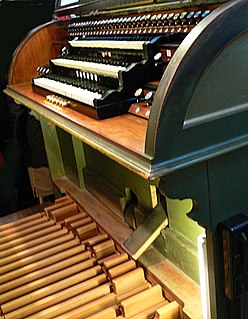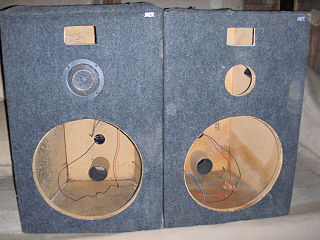The Thingamakit is an analog sound synthesizer kit produced by Bleep Labs. It can be purchased with an optional stompbox-style enclosure (commonly used for guitar effects, but just about any small enclosure can be used to contain the electronics. The Thingamakit is based on voltage controlled oscillators that are commonly used in the production of electronic music. However, this synth is unique in its application of LED outputs and photocell inputs. The LEDs are adjusted to blink at various rates, and they are positioned above the photocells to affect the sound.

A voltage-controlled oscillator (VCO) is an electronic oscillator whose oscillation frequency is controlled by a voltage input. The applied input voltage determines the instantaneous oscillation frequency. Consequently, a VCO can be used for frequency modulation (FM) or phase modulation (PM) by applying a modulating signal to the control input. A VCO is also an integral part of a phase-locked loop.
Electronic music is music that employs electronic musical instruments, digital instruments and circuitry-based music technology. In general, a distinction can be made between sound produced using electromechanical means, and that produced using electronics only. Electromechanical instruments include mechanical elements, such as strings, hammers, and so on, and electric elements, such as magnetic pickups, power amplifiers and loudspeakers. Examples of electromechanical sound producing devices include the telharmonium, Hammond organ, and the electric guitar, which are typically made loud enough for performers and audiences to hear with an instrument amplifier and speaker cabinet. Pure electronic instruments do not have vibrating strings, hammers, or other sound-producing mechanisms. Devices such as the theremin, synthesizer, and computer can produce electronic sounds.
Two LEDs are positioned at the end of flexible extensions known as "LEDacles". The layout of switches, knobs and photocells, combined with the tentacle-like LEDacles, give the appearance of a face. Many users decorate their Thingamakits to look like robots, animals, etc.
The Thingamakit is designed in such a way that it can easily be modified and/or circuit bent to produce a wide variety of experimental sounds. Clear instructions, simple design and low cost make it a good choice for electronic musicians who want to experiment with DIY instruments.

Circuit bending is the creative, chance-based customization of the circuits within electronic devices such as low-voltage, battery-powered guitar effects, children's toys and digital synthesizers to create new musical or visual instruments and sound generators.

A drum kit — also called a drum set, trap set, or simply drums — is a collection of drums and other percussion instruments, typically cymbals, which are set up on stands to be played by a single player, with drumsticks held in both hands, and the feet operating pedals that control the hi-hat cymbal and the beater for the bass drum. A drum kit consists of a mix of drums and idiophones – most significantly cymbals, but can also include the woodblock and cowbell. In the 2000s, some kits also include electronic instruments. Also, both hybrid and entirely electronic kits are used.

An electronic musical instrument is a musical instrument that produces sound using electronic circuitry. Such an instrument sounds by outputting an electrical, electronic or digital audio signal that ultimately is plugged into a power amplifier which drives a loudspeaker, creating the sound heard by the performer and listener.

A subwoofer is a woofer, or a complete loudspeaker, which is dedicated to the reproduction of low-pitched audio frequencies known as bass and sub-bass. The typical frequency range for a subwoofer is about 20–200 Hz for consumer products, below 100 Hz for professional live sound, and below 80 Hz in THX-approved systems. Subwoofers are intended to augment the low frequency range of loudspeakers that cover the higher frequency bands. While the term "subwoofer" technically only refers to the speaker driver, in common parlance, the term often refers to a subwoofer driver mounted in a speaker enclosure (cabinet), often with a built-in amplifier.

A loudspeaker is an electroacoustic transducer; a device which converts an electrical audio signal into a corresponding sound. The most widely used type of speaker in the 2010s is the dynamic speaker, invented in 1925 by Edward W. Kellogg and Chester W. Rice. The dynamic speaker operates on the same basic principle as a dynamic microphone, but in reverse, to produce sound from an electrical signal. When an alternating current electrical audio signal is applied to its voice coil, a coil of wire suspended in a circular gap between the poles of a permanent magnet, the coil is forced to move rapidly back and forth due to Faraday's law of induction, which causes a diaphragm attached to the coil to move back and forth, pushing on the air to create sound waves. Besides this most common method, there are several alternative technologies that can be used to convert an electrical signal into sound. The sound source must be amplified or strengthened with an audio power amplifier before the signal is sent to the speaker.

A microphone, colloquially nicknamed mic or mike, is a transducer that converts sound into an electrical signal.

A mid-range speaker is a loudspeaker driver that reproduces sound in the frequency range from 250 to 2000 Hz. It is also known as a squawker.

A woofer or bass speaker is a technical term for loudspeaker driver designed to produce low frequency sounds, typically from 40 Hz up to 500 Hz. The name is from the onomatopoeic English word for a dog's bark, "woof". The most common design for a woofer is the electrodynamic driver, which typically uses a stiff paper cone, driven by a voice coil surrounded by a magnetic field.

A digital piano is a type of electronic keyboard designed to serve primarily as an alternative to the traditional piano, both in the way it feels to play and in the sound produced. It is intended to provide an accurate simulation of an acoustic piano. Some digital pianos are also designed to look like an ordinary piano, both the upright or grand piano. Digital pianos use either a synthesized emulation or samples of an actual piano, which are then amplified through an internal loudspeaker. Digital pianos incorporate weighted keys, which recreate the feel of an acoustic piano.

An electronic keyboard or digital keyboard is an electronic musical instrument, an electronic or digital derivative of keyboard instruments.
Broadly speaking, the term electronic keyboard or just a keyboard can refer to any type of digital or electronic keyboard instrument. These include synthesizers, digital pianos, stage pianos, electronic organs and digital audio workstations. However, an electronic keyboard is more specifically a synthesizer with a built-in low-wattage power amplifier and small loudspeakers.

A DI unit is an electronic device typically used in recording studios and in sound reinforcement systems to connect a high-output impedance, line level, unbalanced output signal to a low-impedance, microphone level, balanced input, usually via an XLR connector and XLR cable. DIs are frequently used to connect an electric guitar or electric bass to a mixing console's microphone input jack. The DI performs level matching, balancing, and either active buffering or passive impedance matching/impedance bridging to minimize unwanted noise, distortion, and ground loops. DI units are typically metal boxes with input and output jacks and, for more expensive units, “ground lift” and attenuator switches.

The electric upright bass is an electronically amplified version of the double bass that has a minimal or 'skeleton' body, which greatly reduces the size and weight of the instrument. EUBs are plugged into an amplifier and speaker cabinet for performances. The EUB retains enough of the features of the double bass so that double bass players are able to perform on it.

A bass reflex system is a type of loudspeaker enclosure that uses a port (hole) or vent cut into the cabinet and a section of tubing or pipe affixed to the port. This port enables the sound from the rear side of the diaphragm to increase the efficiency of the system at low frequencies as compared to a typical sealed- or closed-box loudspeaker or an infinite baffle mounting.

An expression pedal is an important control found on many musical instruments including organs, electronic keyboards and pedal steel guitar. The musician uses the pedal to control different aspects of the sound, commonly volume. Separate expression pedals can often be added to a guitar amplifier or effects unit and used to control many different aspects of the tone.
In music, a chorus effect occurs when individual sounds with approximately the same time, and very similar pitches converge and are perceived as one. While similar sounds coming from multiple sources can occur naturally, as in the case of a choir or string orchestra, it can also be simulated using an electronic effects unit or signal processing device.

A loudspeaker enclosure or loudspeaker cabinet is an enclosure in which speaker drivers and associated electronic hardware, such as crossover circuits and, in some cases, power amplifiers, are mounted. Enclosures may range in design from simple, homemade DIY rectangular particleboard boxes to very complex, expensive computer-designed hi-fi cabinets that incorporate composite materials, internal baffles, horns, bass reflex ports and acoustic insulation. Loudspeaker enclosures range in size from small "bookshelf" speaker cabinets with 4" woofers and small tweeters designed for listening to music with a hi-fi system in a private home to huge, heavy subwoofer enclosures with multiple 18" or even 21" speakers in huge enclosures which are designed for use in stadium concert sound reinforcement systems for rock music concerts.
The Bushmaster 2000 is an electro-pneumatic paintball marker produced by Indian Creek Designs, (ICD), a manufacturer based in Idaho.
Electronic packaging is the design and production of enclosures for electronic devices ranging from individual semiconductor devices up to complete systems such as a mainframe computer. Packaging of an electronic system must consider protection from mechanical damage, cooling, radio frequency noise emission and electrostatic discharge. Product safety standards may dictate particular features of a consumer product, for example, external case temperature or grounding of exposed metal parts. Prototypes and industrial equipment made in small quantities may use standardized commercially available enclosures such as card cages or prefabricated boxes. Mass-market consumer devices may have highly specialized packaging to increase consumer appeal. Electronic packaging is a major discipline within the field of mechanical engineering.

An experimental musical instrument is a musical instrument that modifies or extends an existing instrument or class of instruments, or defines or creates a new class of instrument. Some are created through simple modifications, such as cracked drum cymbals or metal objects inserted between piano strings in a prepared piano. Some experimental instruments are created from household items like a homemade mute for brass instruments such as bathtub plugs. Other experimental instruments are created from electronic spare parts, or by mixing acoustic instruments with electric components.

The Roland VK-7 is an electronic keyboard introduced in 1997 which simulates the sound of an electromechanical Hammond organ. Like other electronic musical instruments that emulate the sound of the electromechanical tonewheel-based organs formerly manufactured by Hammond, the VK-7 is referred to as a clonewheel organ. Currently it is replaced by the VK-8 and the VK-88.

A bridge is a device that supports the strings on a stringed musical instrument and transmits the vibration of those strings to another structural component of the instrument—typically a soundboard, such as the top of a guitar or violin—which transfers the sound to the surrounding air. Depending on the instrument, the bridge may be made of carved wood, metal or other materials. The bridge supports the strings and holds them over the body of the instrument under tension.


















